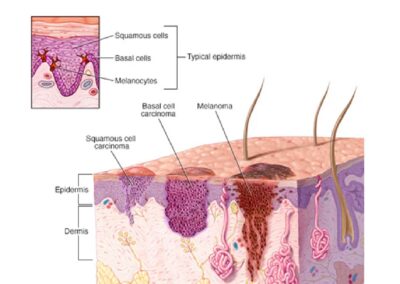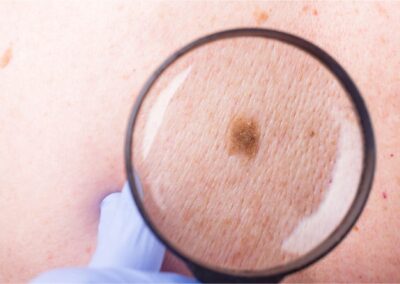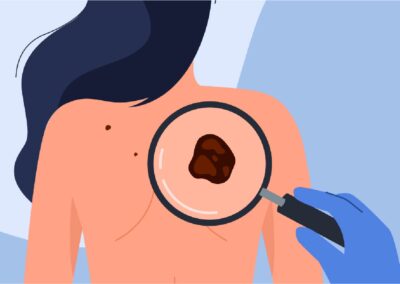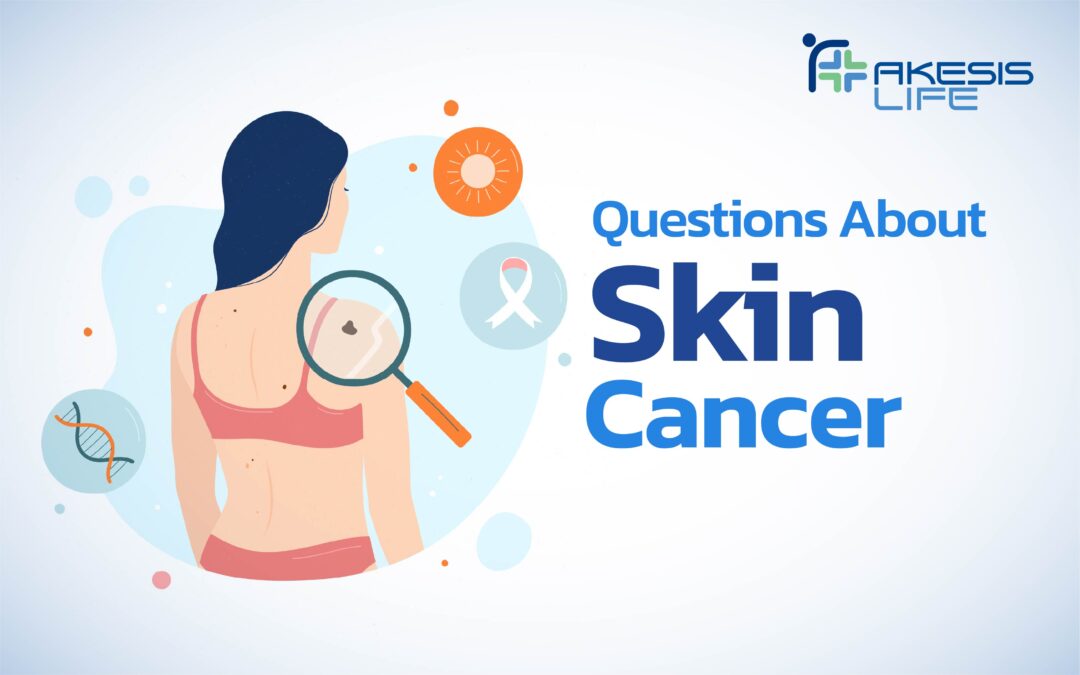How many types of skin cancer are there?
There are three common types of skin cancer:

- Melanoma
Melanoma is a type of skin cancer that originates from melanocytes—pigment-producing cells in the skin. It often develops in areas exposed to high levels of UV radiation, such as the face, arms, and legs, though it may also occur in areas not typically sun-exposed, such as the nail bed or eyes.

Key signs to watch for include:
- Abnormally dark pigmented spots on the skin
- Lesions resembling moles or birthmarks, but with irregular colors (dark and light mixed), asymmetric shapes, uneven borders, and rapid growth
- May become elevated, itchy, and bleed
- Can present at any stage, from early localized lesions to metastatic spread
- Melanoma is considered the most aggressive type of skin cancer
- Basal Cell Carcinoma (BCC)
Basal cell carcinoma is the most common type of skin cancer. It arises from the basal cells in the epidermis and is typically linked to UV radiation exposure. While it is more frequent in fair-skinned individuals, it can also develop in Asians after prolonged sun exposure.
Typical appearance:
- A pearly or flesh-colored bump, often pinkish
- Rarely metastasizes to other areas of the body

- Squamous Cell Carcinoma (SCC)
This is the second most common skin cancer. It originates from squamous cells in the skin and typically appears as a red bump or patch with a crust. Lesions may disappear and recur.
Risk factors:
- Chronic sun exposure and UV radiation
- SCC may develop from Actinic Keratosis, a precancerous skin condition
- More likely than BCC to invade deeper layers of skin

Standard Treatment Based on Stage
All skin cancer treatments depend on the stage of the disease. All patients are advised to avoid excessive sun exposure and use broad-spectrum sunscreen (UVA/UVB) with SPF 30 or higher and water resistance.
Cancer Type | Early Stage Treatment | Advanced Stage Treatment |
Melanoma | Surgical excision | Immunotherapy and targeted therapy |
Basal cell carcinoma |
| Targeted therapy (Hedgehog pathway inhibitors) |
Squamous cell carcinoma | Surgical excision (may include radiation) | Immunotherapy |
Complementary Treatments for Early-Stage Skin Cancer
Cancer Type | Complementary Therapies |
Melanoma | Nutrition, Acupuncture, Phytochemical Extract (EGCG, Curcumin, Proanthocyanidin) |
Basal cell carcinoma | Nicotinamide (B3) Photodynamic Therapy, Light Therapy (LED) |
Squamous cell carcinoma | Nicotinamide (B3), Retinoid, Aminolevulinic acid Photodynamic Therapy, Light Therapy (LED) |
Complementary Treatments for Metastatic Skin Cancer
- Evaluation by a medical specialist is required to determine the spread of the cancer to other organs or systems.
- Review of the current hospital-based treatment protocol is essential.
- Complementary treatments aim to:
- Support the primary therapy
- Reduce drug-related side effects
- Help maintain patient strength throughout conventional treatment
- Lifestyle and immune system support through personalized nutrition, appropriate exercise, and rehabilitation techniques, including heat therapy and light therapy
- Nutritional supplementation based on the patient’s condition, such as malnutrition or significant weight loss
- Ozone therapy may be considered in cases with chronic non-healing skin ulcers or infections, as it can aid in healing and inflammation control
- https://www.nccn.org/professionals/physician_gls/pdf/nmsc.pdf
- https://www.nccn.org/professionals/physician_gls/pdf/squamous.pdf
- Villani A, Potestio L, Fabbrocini G, Scalvenzi M. New Emerging Treatment Options for Advanced Basal Cell Carcinoma and Squamous Cell Carcinoma. Adv Ther. 2022 Mar;39(3):1164-1178. doi: 1007/s12325-022-02044-1. Epub 2022 Jan 28. PMID: 35089534; PMCID: PMC8918118
- McDaniel B, Badri T, Steele RB. Basal Cell Carcinoma. [Updated 2022 Sep 19]. In: StatPearls [Internet]. Treasure Island (FL): StatPearls Publishing; 2024 Jan-. Available from: https://www.ncbi.nlm.nih.gov/books/NBK482439/
- Tosti G, Pepe F, Gnagnarella P, Silvestri F, Gaeta A, Queirolo P, Gandini S. The Role of Nicotinamide as Chemo-Preventive Agent in NMSCs: A Systematic Review and Meta-Analysis. Nutrients. 2024; 16(1):100. https://doi.org/10.3390/nu16010100
- Sun J, Zhao H, Fu L, Cui J, Yang Y. Global Trends and Research Progress of Photodynamic Therapy in Skin Cancer: A Bibliometric Analysis and Literature Review. Clin Cosmet Investig Dermatol. 2023 Feb 21;16:479-498. doi: 2147/CCID.S401206. PMID: 36851952; PMCID: PMC9961166.
- Zhao, G., Han, X., Zheng, S., Li, Z., Sha, Y., Ni, J., Sun, Z., Qiao, S., Song, Z.”Curcumin induces autophagy, inhibits proliferation and invasion by downregulating AKT/mTOR signaling pathway in human melanoma cells”. Oncology Reports 35, no. 2 (2016): 1065-1074. https://doi.org/10.3892/or.2015.4413
- Tang Y, Cao Y. Curcumin Inhibits the Growth and Metastasis of Melanoma via miR-222-3p/SOX10/Notch Axis. Dis Markers. 2022 May 9;2022:3129781. doi: 10.1155/2022/3129781. PMID: 35585935; PMCID: PMC9110126.
- Vaid, M., Singh, T., Prasad, R., Katiyar, S. K.”Bioactive proanthocyanidins inhibit growth and induce apoptosis in human melanoma cells by decreasing the accumulation of β-catenin”. International Journal of Oncology 48, no. 2 (2016): 624-634. https://doi.org/10.3892/ijo.2015.3286
- Ravindran Menon D, Li Y, Yamauchi T, Osborne DG, Vaddi PK, Wempe MF, Zhai Z, Fujita M. EGCG Inhibits Tumor Growth in Melanoma by Targeting JAK-STAT Signaling and Its Downstream PD-L1/PD-L2-PD1 Axis in Tumors and Enhancing Cytotoxic T-Cell Responses. Pharmaceuticals (Basel). 2021 Oct 26;14(11):1081. doi: 10.3390/ph14111081. PMID: 34832863; PMCID: PMC8618268.


